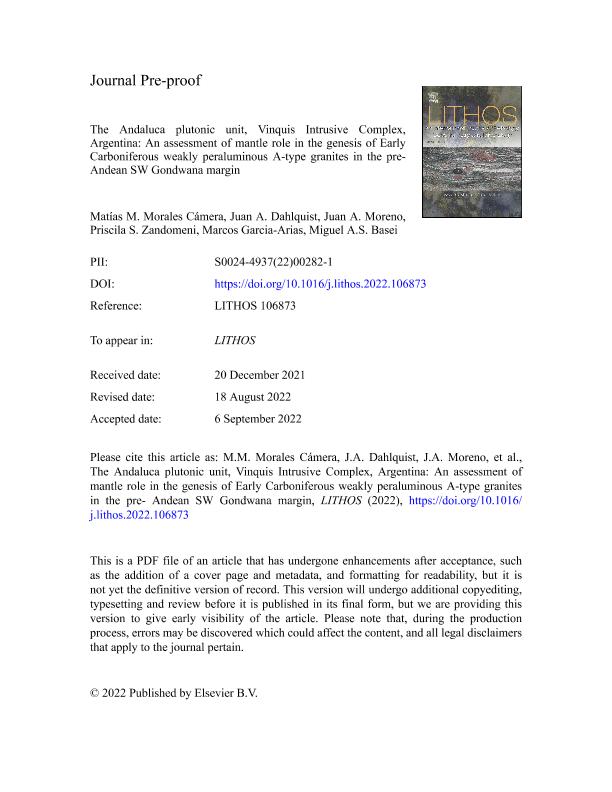Mostrar el registro sencillo del ítem
dc.contributor.author
Morales Camera, Matías Martín

dc.contributor.author
Dahlquist, Juan Andrés

dc.contributor.author
Moreno Moreno, Juan Antonio

dc.contributor.author
Zandomeni, Priscila Soledad

dc.contributor.author
García Arias, Marcos

dc.contributor.author
Stipp Basei, Miguel Angelo

dc.date.available
2023-07-12T15:40:46Z
dc.date.issued
2022-12
dc.identifier.citation
Morales Camera, Matías Martín; Dahlquist, Juan Andrés; Moreno Moreno, Juan Antonio; Zandomeni, Priscila Soledad; García Arias, Marcos; et al.; The Andaluca plutonic unit, Vinquis Intrusive Complex, Argentina: An assessment of mantle role in the genesis of Early Carboniferous weakly peraluminous A-type granites in the pre-Andean SW Gondwana margin; Elsevier Science; Lithos; 434-435; 106873; 12-2022; 1-57
dc.identifier.issn
0024-4937
dc.identifier.uri
http://hdl.handle.net/11336/203495
dc.description.abstract
During the Early Carboniferous, significant intracontinental magmatism was developed in the retro-arc region of the SW margin of Gondwana between ca. 27° and 31°S. This magmatism consisted of metaluminous to weakly peraluminous A-type granites, strongly peraluminous A-type granites (A- to S- hybrid granitoids) and, to a lesser extent, (sub-)volcanic felsic (rhyolites and trachytes) and mafic (alkaline basalts and lamprophyres) rocks. The Vinquis Intrusive Complex (VIC) registers these two compositional varieties of A-type granites: the Vinquis Unit (VU) represents the strongly peraluminous granites and the Andaluca Unit (AU) the weakly peraluminous granites. The adjacent Zapata Intrusive Complex (ZIC) also contains metaluminous to weakly peraluminous A-type granites. The AU is a semi-elliptical plutonic body of approximately 60 km2 located in the southwestern part of the VIC, intruding the Vinquis Unit. The AU comprises three dominant rock types: i) quartz monzonite, ii) syenogranite and iii) alkali feldspar granite that can be classified as F-rich ferroan and weakly peraluminous A-type granitoids (calculated F content 1950–5700 ppm, [FeOt/(FeOt + MgO] = 0.86–0.95, ASI = 1.03–1.10, [Zr + Nb + Ce +Y] = 364–570 ppm, Ga = 20–23 ppm, SiO2= 68.5–75.1%). This unit was emplaced in early Carboniferous time with U-Pb zircon crystallization ages of 346 ± 3 Ma and 342 ± 3 Ma. The AU has 87Sr/86Srt, εNdt and εHft values ranging from 0.7092 to 0.7140, −2.6 to −3.6 and −16.5 to −3.3, respectively. These isotopic compositions suggest that the parental magma of AU involved variable mixtures of mantle-derived components (magmas/fluids) and peraluminous continental crust. The extremely felsic granites of the AU (SiO2 > ∼72%) have a strongly fractionated composition (Rb > 336 and Sr < 70 ppm and Eu/Eu* < 0.22) that suggests extensive fractional crystallization. The high contents of fluorine and HFSE could be explained as derived from a parental mafic magma rich in F, HFSE, and alkalis plus contributions from F-bearing minerals assimilated from the country rock. Magmatic differentiation of these reduced mafic magmas could also explain the ferroan character of the AU granitoids. We envisage three stages in the origin of these rocks: (1) fluids and magmas from the asthenospheric mantle metasomatize and melt the subcontinental lithospheric mantle (SCLM), the alkali-rich mafic melts produced are emplaced at the base of the crust, transfer heat to the crust and melt it, generating strongly peraluminous A-type magmas; (2) continued introduction of alkali-rich mafic magmas into the deep crust produces extensive assimilation of the preheated crust in equilibrium with mafic cumulates (generated by reaction and/or fractionation); (3) the hot magmas so produced migrate into the middle-upper crust as weakly peraluminous ferroan A-type granitoids.
dc.format
application/pdf
dc.language.iso
eng
dc.publisher
Elsevier Science

dc.rights
info:eu-repo/semantics/openAccess
dc.rights.uri
https://creativecommons.org/licenses/by-nc-nd/2.5/ar/
dc.subject
FERROAN GRANITES
dc.subject
FLUORINE-RICH GRANITIC MAGMA
dc.subject
HF AND ND ISOTOPES
dc.subject
IGNEOUS GEOCHEMISTRY
dc.subject
INTRACONTINENTAL MAGMATISM
dc.subject
U-PB DATING
dc.subject.classification
Geología

dc.subject.classification
Ciencias de la Tierra y relacionadas con el Medio Ambiente

dc.subject.classification
CIENCIAS NATURALES Y EXACTAS

dc.title
The Andaluca plutonic unit, Vinquis Intrusive Complex, Argentina: An assessment of mantle role in the genesis of Early Carboniferous weakly peraluminous A-type granites in the pre-Andean SW Gondwana margin
dc.type
info:eu-repo/semantics/article
dc.type
info:ar-repo/semantics/artículo
dc.type
info:eu-repo/semantics/publishedVersion
dc.date.updated
2023-07-07T17:16:48Z
dc.journal.volume
434-435
dc.journal.number
106873
dc.journal.pagination
1-57
dc.journal.pais
Países Bajos

dc.journal.ciudad
Amsterdam
dc.description.fil
Fil: Morales Camera, Matías Martín. Consejo Nacional de Investigaciones Científicas y Técnicas. Centro Científico Tecnológico Conicet - Córdoba. Centro de Investigaciones en Ciencias de la Tierra. Universidad Nacional de Córdoba. Facultad de Ciencias Exactas Físicas y Naturales. Centro de Investigaciones en Ciencias de la Tierra; Argentina
dc.description.fil
Fil: Dahlquist, Juan Andrés. Consejo Nacional de Investigaciones Científicas y Técnicas. Centro Científico Tecnológico Conicet - Córdoba. Centro de Investigaciones en Ciencias de la Tierra. Universidad Nacional de Córdoba. Facultad de Ciencias Exactas Físicas y Naturales. Centro de Investigaciones en Ciencias de la Tierra; Argentina
dc.description.fil
Fil: Moreno Moreno, Juan Antonio. Universidad Complutense de Madrid; España
dc.description.fil
Fil: Zandomeni, Priscila Soledad. Consejo Nacional de Investigaciones Científicas y Técnicas. Centro Científico Tecnológico Conicet - Córdoba. Centro de Investigaciones en Ciencias de la Tierra. Universidad Nacional de Córdoba. Facultad de Ciencias Exactas Físicas y Naturales. Centro de Investigaciones en Ciencias de la Tierra; Argentina
dc.description.fil
Fil: García Arias, Marcos. Universidad de Salamanca; España
dc.description.fil
Fil: Stipp Basei, Miguel Angelo. Universidade de Sao Paulo; Brasil
dc.journal.title
Lithos

dc.relation.alternativeid
info:eu-repo/semantics/altIdentifier/url/https://www.sciencedirect.com/science/article/pii/S0024493722002821
dc.relation.alternativeid
info:eu-repo/semantics/altIdentifier/doi/http://dx.doi.org/10.1016/j.lithos.2022.106873
Archivos asociados
